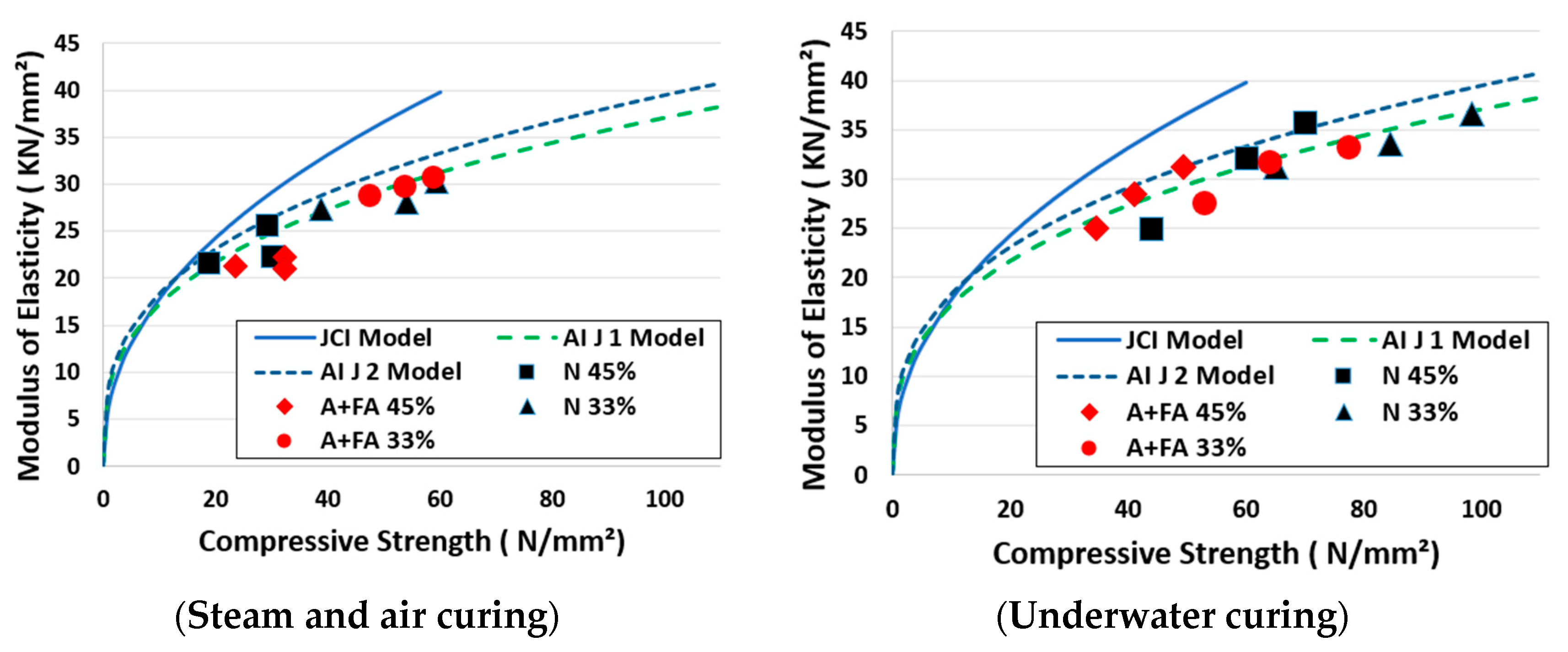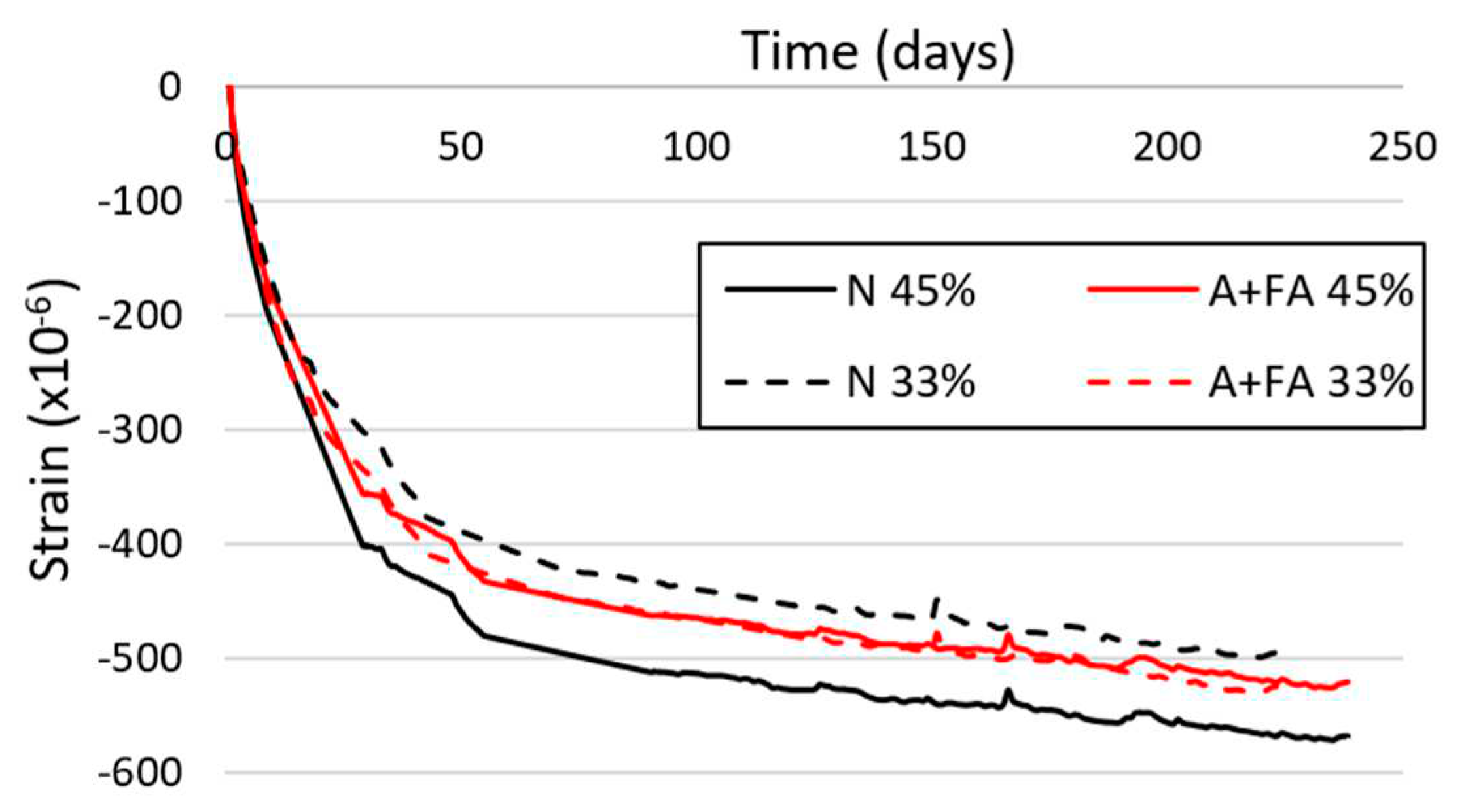Submitted:
20 September 2023
Posted:
21 September 2023
You are already at the latest version
Abstract
Keywords:
1. Introduction
2. Materials and Mix Proportions
3. Experimental procedures
3.1. Compressive strength and modulus of elasticity
3.2. Autogenous and Drying shrinkage
3.3. Adiabatic temperature rise
3.4. Thermal stress analysis using three-dimensional finite element method (3-D FEM)




4. Results and Discussions
4.1. Properties of concrete
4.1.1. Fresh properties
4.1.2. Compressive strength and Modulus of elasticity
4.1.3. Autogenous and Drying Shrinkage
4.1.4. Adiabatic temperature rise

4.2. Thermal stress analysis
4.2.1. Thermal stress during steam curing
4.2.2. Drying shrinkage stress after steam curing
| Mix Proportion | During steam curing | After steam curing up to 6 months | ||
|---|---|---|---|---|
| Region 1 | Region 1 | Region 2 | Region 3 | |
| N 45% | 0.89 | 0.52 | 0.52 | 0.75 |
| A+FA 45% | 1.15 | 0.63 | 0.63 | 0.91 |
5. Conclusions
- Steam-cured concrete with modified fly ash and high alite cement develops higher compressive strength on the first day of age than concrete with ordinary Portland cement.
- There are no big differences in the modulus of elasticity between the steam-cured concrete and the underwater-cured concrete regardless of fly ash addition.
- The concrete with fly ash has larger drying shrinkage values than the normal concrete when (W/B=33%), but when (W/B=45%) the drying shrinkage of the concrete with fly ash was less than it was in the concrete with (N).
- It is proved from FEM stress analysis for a steam-cured box culvert that the effect of autogenous shrinkage on cracking probability was very small, it can be said that thermal shrinkage was the dominant factor for generating internal stresses in the concrete at the early age, On the other hand, drying shrinkage was dominated at later ages due to decrease of internal humidity of the concrete.
- Using the proposed fly ash cement with high alite cement and modified fly ash improves the cracking resistance of the precast concrete box culvert more than OPC during steam curing process.
- After steam curing, drying shrinkage is the main cause of cracking in the precast concrete box culvert at later ages regardless of the type of binder.
Author Contributions
Acknowledgments
References
- Sugandha, S.; Manas, K.G.; Kamal, K.K. Extraction of Unburned Carbon from Coal Fly Ash. Handbook of Fly Ash. 2022, 403–449. [Google Scholar]
- Sakai, E.; Umetsu, M.; Matsuzawa, K.; Kuga, R. Properties of Fly Ash Treated by Electrostatic Belt Separation Method. Cement Science and Concrete Technology 2019, 73, 65–70, in Japanese. [Google Scholar] [CrossRef]
- Habeeb, G.; Zainab, H.; Sattar Ghali, A. Effect of Accelerated Curing on Compressive Strength of High Strength Concrete with Nano-Silica. 2015. (PDF) EFFECT OF ACCELERATED CURING ON COMPRESSIVE STRENGTH OF HIGH STRENGTH CONCRETE WITH NANO- SILICA (researchgate.net).
- Vollenweider, B. Various methods of accelerated curing for precast concrete applications, and their impact on short and long term compressive strength. Concrete Technology 2004, 241, 1–22. [Google Scholar]
- Japan Standards Association, JIS A 6201, Fly ash for use in concrete; Japanese Standards Association: Tokyo, Japan, 2012.
- Portland Cement Association; National Ready Mixed Concrete Association; MIT CSHub; Improving Concrete Sustainability through Alite and Belite Reactivity, MIT Concrete Sustainability Hub. September 2013. https://cshub.mit.edu/sites/default/files/documents/alite-belite-whitepaper.pdf.
- Benson, K.; Teng, Z.; Miyazawa, S.; Sakai, E.; Nito, N.; Hirao, H. Effect of C3S content of clinker on properties of fly ash cement concrete. Construction and Building Materials 2020, 240. Effect of C3S content of clinker on properties of fly ash cement concrete - ScienceDirect. [Google Scholar]
- Klemczak, B.; Jedrzejewska, A. Early age thermal and shrinkage cracks in concrete structures- Description of the problem. Chemistry 2011, 4, 35–47, (PDF) Early age thermal and shrinkage cracks in concrete structures - Description of the problem (researchgate.net). [Google Scholar]
- Bamforth, P.B. Early-Age Thermal Crack Control in Concrete; CIRIA C660: London, UK, 2007; Available online: https://www1.ing.unlp.edu.ar/catedras/C1130/descargar.php?secc=0&id=C0130&id_inc=54286.
- Mihashi, H.; de Barros Leite, J.P. State-of-the-art report on control of cracking in early age concrete. J. Adv. Concr. Technol. 2004, 2, 141–154, State-of-the-Art Report on Control of Cracking in Early Age Concrete (jst.go.jp). [Google Scholar] [CrossRef]
- Klemczak, B.; Maciej, B.; Maciej, P.; Aneta, ĩ. Analysis of cracking risk in early age mass concrete with different aggregate. Procedia Eng. 2017, 193, 234–241, Analysis of Cracking Risk in Early Age Mass Concrete with Different Aggregate Types - ScienceDirect. [Google Scholar] [CrossRef]
- Japanese Standards Association. JIS R 5210: Portland Cement; Japanese Standards Association: Tokyo, Japan, 2009. [Google Scholar]
- Japanese Standards Association. JIS A1108: Method of Test for Compressive Strength of Concrete; Japanese Standards Association: Tokyo, Japan, 2006. [Google Scholar]
- ASTM International. ASTM C39/C39M-18: Standard Test Method for Compressive Strength of Cylindrical Concrete Specimens; ASTM International: West Conshohocken, PA, USA, 2018. [Google Scholar]
- Japan Society of Civil Engineers. Recommendation for Construction of Self-Compacting Concrete; Technical Session: Recommendations and Materials: Tokyo, Japan, 1998; pp. 417–437. [Google Scholar]
- Cement Concrete and Aggregates Australia. Drying Shrinkage of Cement and Concrete; Cement Concrete and Aggregates Australia: Sydney, Australia, 2002. [Google Scholar]
- Japan Concrete Institute. Guidelines for Control of Cracking of Mass Concrete; Japan Concrete Institute: Tokyo, Japan, 2016. [Google Scholar]
- Jang, I.; Maruyama, I. Numerical Predication of crack width in massive concrete member due to heat of hydration. CONCRACK 2017, 5, 91–100. [Google Scholar]
- Japanese Standards Association. JIS A 5372: Precast reinforced concrete products; Japanese Standards Association: Tokyo, Japan, 2016. [Google Scholar]
- K. Nijs, K.; Ishikawa, M. Finite Element Implementation of a Drying Shrinkage Model Based on Pore Evaporation Mechanics, High Tech Concrete: Where Technology and Engineering Meet; Springer International Publishing AG, 2018; pp. 49–55. [Google Scholar]
- Tazawa, E.; Miyazawa, S. Tensile and flexural strength of cement mortar subjected to non-uniform self-stress. Magazine of Concrete Research 1992, 161, 241–248. [Google Scholar] [CrossRef]
- Japan Concrete Institute. Guidelines for Modulus of elasticity; Japan Concrete Institute: Tokyo, Japan, 2016. [Google Scholar]
- Architectural Institute of Japan. State of the Report on High Strength Concrete; Architectural Institute of Japan: Tokyo, Japan, 2009. [Google Scholar]


















| Name | Density (g/cm3) |
Blaine fineness (cm2/g) |
f.CaO (%) |
Mineral composition (%) | |||
|---|---|---|---|---|---|---|---|
| C3S | C2S | C3A | C4AF | ||||
| A | 3.11 | 5380 | 2.1 | 69.3 | 2.9 | 9.4 | 7.7 |
| N | 3.16 | 3170 | 0.2 | 61.6 | 15.1 | 8.2 | 9.1 |
| Name | Density (g/cm3) |
Blaine fineness (cm2/g) |
SiO2 (%) |
Ig. Loss (%) |
Flow percent of control (%) | Methylene blue adsorption (mg/g) | Strength Activity Index (%) | ||
|---|---|---|---|---|---|---|---|---|---|
| 7days | 28days | 91days | |||||||
| FA-1 | 2.24 | 3900 | 59.7 | 5.2 | 101 | 1.96 | 74 | 82 | 92 |
| FA-2 | 2.25 | 4030 | 63.9 | 0.8 | 106 | 0.53 | 78 | 85 | 97 |
| FA | 2.19 | 3490 | 65.3 | 0.9 | 106 | 0.33 | 74 | 84 | 99 |
| Proportion | W/B (%) |
s/a (%) |
Amounts of contents (kg/m3) | Chemical Admixture (B X %) | |||||||
|---|---|---|---|---|---|---|---|---|---|---|---|
| Water | N | A | FA | S | G | SP | AE303 | AE785 | |||
| N 45% | 45 | 45 | 160 | 356 | … | … | 795 | 993 | 0.8 | 0.001 | … |
| A+FA 45% | 45 | 160 | … | 292 | 64 | 783 | 977 | 0.75 | … | 0.03 | |
| N 33% | 33 | 43 | 160 | 485 | … | … | 715 | 967 | 0.88 | 0.0015 | … |
| A+FA 33% | 43 | 160 | … | 398 | 87 | 699 | 946 | 0.8 | … | 0.035 | |
| Aggregates | Provenance | Maximum size (mm) |
Density (g/cm3) |
Absorption (%) |
Fineness modulus | |
|---|---|---|---|---|---|---|
| Coarse aggregates (a) | Sandstone from Kuzu region | 20 | 2.62 | 0.76 | … | |
| Fine aggregates (sand) | River sand from Kinugawa river | … | 2.60 | 2.11 | 2.75 |
| Proportion | W/B (%) |
Fresh Properties | ||
|---|---|---|---|---|
| Slump (cm) | Air content (%) | Temperature at casting (°C) | ||
| N 45% | 45 | 12.2 | 5.4 | 18.0 |
| A+FA 45% | 11.4 | 5.2 | 18.5 | |
| N 33% | 33 | 13.1 | 4.7 | 18.5 |
| A+FA 33% | 11.6 | 4.3 | 18.0 | |
Disclaimer/Publisher’s Note: The statements, opinions and data contained in all publications are solely those of the individual author(s) and contributor(s) and not of MDPI and/or the editor(s). MDPI and/or the editor(s) disclaim responsibility for any injury to people or property resulting from any ideas, methods, instructions or products referred to in the content. |
© 2023 by the authors. Licensee MDPI, Basel, Switzerland. This article is an open access article distributed under the terms and conditions of the Creative Commons Attribution (CC BY) license (http://creativecommons.org/licenses/by/4.0/).




